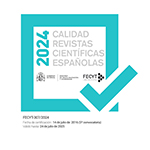Redes de coautoría como herramienta de evaluación de la producción científica de los grupos de investigación
Resumen
Muestra la importancia del uso de indicadores relacionales en los estudios de análisis de la producción científica de grupos de investigación, con el fin de determinar sus dinámicas de publicación, haciendo énfasis en medidas como la centralidad, la densidad y el tamaño de la red. Se presenta una red de coautoría que visualiza la colaboración entre grupos y las dinámicas de colaboración dentro de cada grupo. Así mismo, se ejemplifica con un caso de estudio, el cálculo de indicadores de la red y su relación con indicadores de productividad. La muestra analizada corresponde a los artículos científicos reportados por 8 grupos de investigación del área de Biología de una Institución de Educación Superior en Colombia, publicaciones vinculadas a los GrupLac de la plataforma ScienTI por cada grupo de investigación. Para elaborar y visualizar la red se utilizó el software Pajek. Se encontró que los grupos de investigación analizados presentan, en general, baja densidad, es decir, un bajo número de vínculos o relaciones entre los autores, igualmente un bajo vínculo entre los grupos de la misma institución en el área de estudio.Descargas
Descarga artículo
Licencia
La Revista General de Información y Documentación, para fomentar el intercambio global del conocimiento, facilita el acceso sin restricciones a sus contenidos desde el momento de su publicación en la presente edición electrónica, y por eso es una revista de acceso abierto. Los originales publicados en esta revista son propiedad de la Universidad Complutense de Madrid y es obligatorio citar su procedencia en cualquier reproducción total o parcial. Todos los contenidos se distribuyen bajo una licencia de uso y distribución Creative Commons Reconocimiento 4.0 (CC BY 4.0). Esta circunstancia ha de hacerse constar expresamente de esta forma cuando sea necesario. Puede consultar la versión informativa y el texto legal de la licencia.











